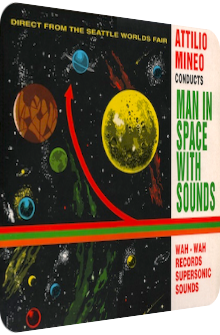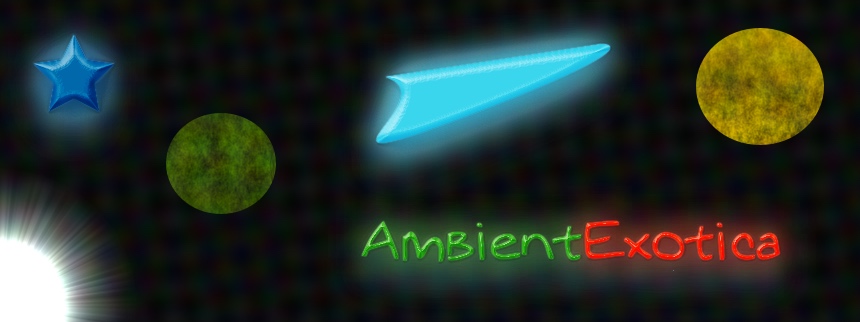
Attilio Mineo
Man In Space With Sounds
1959
A slightly abridged version of this review appears on the vinyl version of the Man In Space With Sounds commemorative reissue, released in January 2017 on the Sundazed label.
Man In Space With Sounds is a commemorative album of 12 tracks dedicated to the Seattle State World’s Fair that took place in 1962. Envisioned and conducted by Attilio “Art” Mineo (born 1918), this Space-Age album is released on World’s Fair Records in 1959 already, but its roots go as far back as 1951 when Mineo carved out many of the uncannily clandestine melodies. It is only in the wake of the World’s Fair that he takes the pieces from his archive and pulls a Space-Age stunt if there ever was one. It’s a stunt for the fan at least, as Mineo’s music has been largely forgotten. This record, however, cannot be forgotten once it is heard, no, encountered: the pool of symphonic instruments is not particularly alienating, but three columns make this a very strong effort.
For one, the tone sequences themselves are enormously portentous and eerie, sometimes scarily so, outshining even Russ Garcia’s Fantastica (1958). Secondly, electronic beeps, effectful molecules and powerful jet engines grace the record. They can admittedly be called gimmicky, though they do serve as constituents of the aura in my opinion. But it’s the third ingredient that makes all the difference: there’s an unnamed narrator/announcer on board who proudly explains the wonders of technology, man’s progress in space, the exciting lives we’re living in the future. The guy is absolutely into it, you hear pride and a pinch of snarkiness in every syllable. Coupled with the apocalyptic circumambience, a surreal reticulation ensues. But wait, doesn’t an omnipresent announcer kill off the immersion and break the flow? Well, not in this case, I believe. But even if it were so, there’s an aesthetically pleasing – and affordable – solution for that, but first, an analysis of the 12 gems.
One of the greatest and most promising titles whose gustatory aura tastes like freedom, technocracy and advancement, Welcome To Tomorrow is the key to a string-infused elevator that lifts off into a particularly effervescent future. In lieu of overly maudlin violin washes, however, mysterious tones become unraveled all the while the excited announcer welcomes the listener and promises a “truly out of this world tour straight into the heart of the future.” It is only then that the pressure prospers: oscillating flutes, metallic horns and histrionic ping-pong echoes make for a semi-fearsome opener, with the following Gayway To Heaven remaining in these recondite climes and even augments them via buzzing sawtooth disk saws attached to a Gothic eight-note string motif. The only mellow delight is added by a layer of viridian vibes, but rest assured that the future is most certainly alienating.
These two compositions are no coincidental black sheep though: the whole LP bundles up guttersnipe melodies and etiolated contretemps which are all the more delightfully dazzling within the announcer’s sphere of action. On Soaring Science, the presence is shifted to a rocket flight complete with a rumbling ignition sequence, spheroidal magenta illusions in the shape of eldritch strings as well as an increasingly irritating alloy of patchy pulses and morse codes. The simultaneity of beguiling euphony – hidden far away – and tense melodies make this one a stellar inclusion.
The short interlude Mile-A-Minute Monorail meanwhile proposes “the world’s first rapid monorail, your’s to enjoy here and now!” It is indeed here and now that Art Mineo succumbs to surreal convulsions as the powerful drones of electric current whirr around staccato guitar twangs of Horror, whereas Around The World is ablaze with pristine blotches, glacial icicle blebs and other piercing molecules. Sound, sustain and silence unite, polyrhythmic Hammond organs and ligneous xylophones round off a cosmic paroxysm before Century 21 finishes side A with an inebriated burlesque of circus organs, tipsily galloping bongo beats and electronic hydrazine expectorations of the cacophonous kind that enclose the listening subject like a glaucous ignis fatuus.
Side B isn’t much kinder, for it writhes, cracks and pinches the nullspace until a weird effulgence takes over possession of the album’s endemic universe. The Seattle World Fair continues with Man In Art, a sub-zero whorl with a snake charmer tenor saxophone in its epicenter. Surrounded by crepuscular pulses, there is indeed a superimposition of mellifluous harp licks and vibe veils grafted onto the enigmatic scene, providing aural aphorisms of delight in a galaxy engulfed in chaos. The string segue in the last third is the greatest of the album. Not necessarily memorable per se, it is still worthwhile since it is not based on a repeated motif and rather branches out, oozes along and eventually vaporizes in order to make room for The Queen City “rising from the water’s edge.” It remains a foggy-nebulous affair with distant strings hued in a lactic haze of legato strings and flutes. Wooden bubbles, warp engines and all sorts of crinkles are much more upfront; the composition therefore provides a great depth of field.
Man Seeks The Future is a delphic diorama of scientific innovation and brings back the pompous brass stabs that are now embedded in reverberated caustic solutions of subverted strings. The rising motif, coupled with shrill flutes and mountainous woodwinds, makes for an alienating experience and is much more based on suspense horror than bona fide awe. The Boeing Spacearium meanwhile promises trips to Mars and Jupiter as well as faraway galaxies, but apart from this colorful promise, the composition succeeds with its quietude: stacked woodwinds, aureate strings and aquatic blebs are twirling and pulsating comparatively peacefully before the announcer asks the listener to “stand by for surprises” in Science Of Tomorrow where “man’s triumph over disease” is translated into music via heavily bustling string helixes, tumbling flutes and cinematic outbursts. Space Age World’s Fair finally kisses the listener goodbye with an appendix that runs for less than a mile, er, minute. A few melodic sketches, modular jitters and harp coils are presented. Afterwards, the listener is back where he or she belongs, ringing ears included.
Man In Space With Sounds offers an allure that leads astray from the beaten Space-Age parts of harmony and glamour. Not only is it an authentic artifact of the Seattle World Fair, it even existed 10 years prior to the iconic event, at least in the shape of sheet music. Art Mineo has created an extremely bewildering trip through the cosmos, and if it weren’t for the excited announcer and tour guide, chances are that the listener were to miss the fact that the glory of technology and mankind is celebrated here. This could indeed be the case, as there are two vinyl versions out there, one which leaves the sphere of the announcer intact, and another where the guy is completely amiss. While this might indeed be the more immersive version as no bellowing voice is interfering with Mineo’s galactic craftsmanship, I believe that his inclusion works flawlessly and even ennobles the release when it is seen as a commemorative LP. The explanations of what the listener is about to see help carving out a vortex of wonders.
The soundscape itself is beautifully texturized as well, but make no mistake: Man In Space With Sounds is not for the faint of heart: many of its movements, patterns and harmonies are downright creepy and scary, leaving crevasses in one’s soul at best. The undulation of colors and the cavalcade of bleeps, blips and machineries are sometimes farcical and destroy what little euphony is left to absorb. Then again, this is a proper Space-Age album where the gruesome vastness of space is depicted and followed through. Not many composers dare to venture into these realms of twilight. When the announcer is there to take your hand, solace and comfort are even amplified. Regardless of which version one prefers, they have both been regained by Stefan Kéry and released on his Subliminal Sounds label in 1998 already. They are pressed onto the same CD. This is the kind of comfort the Seattle State World’s Fair promised!
Exotica Review 408: Attilio Mineo – Man In Space With Sounds (1959). Originally published on Jan. 17, 2015 at AmbientExotica.com.
